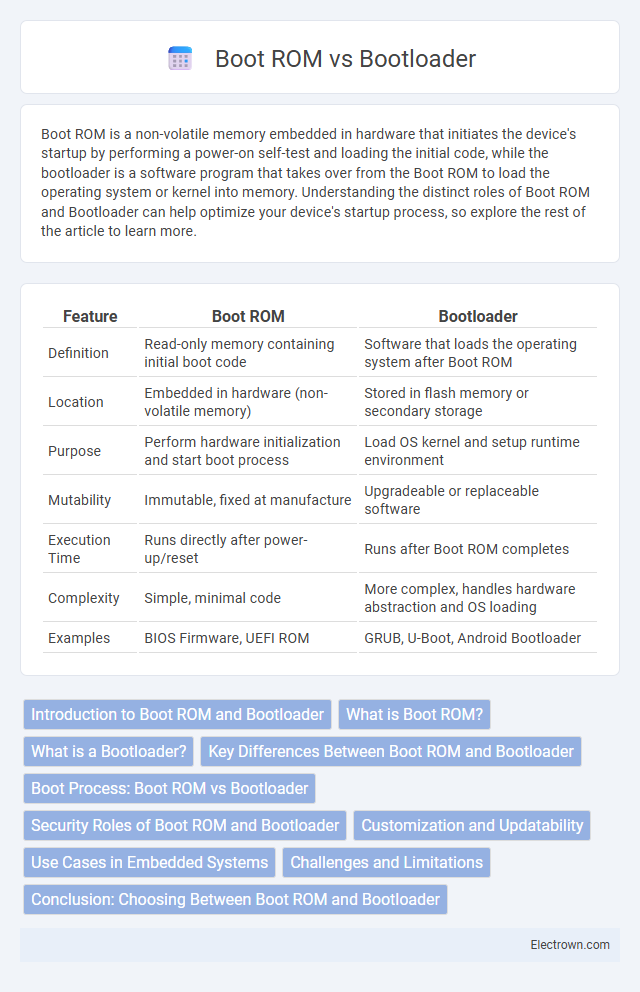Boot ROM is a non-volatile memory embedded in hardware that initiates the device's startup by performing a power-on self-test and loading the initial code, while the bootloader is a software program that takes over from the Boot ROM to load the operating system or kernel into memory. Understanding the distinct roles of Boot ROM and Bootloader can help optimize your device's startup process, so explore the rest of the article to learn more.
Table of Comparison
| Feature | Boot ROM | Bootloader |
|---|---|---|
| Definition | Read-only memory containing initial boot code | Software that loads the operating system after Boot ROM |
| Location | Embedded in hardware (non-volatile memory) | Stored in flash memory or secondary storage |
| Purpose | Perform hardware initialization and start boot process | Load OS kernel and setup runtime environment |
| Mutability | Immutable, fixed at manufacture | Upgradeable or replaceable software |
| Execution Time | Runs directly after power-up/reset | Runs after Boot ROM completes |
| Complexity | Simple, minimal code | More complex, handles hardware abstraction and OS loading |
| Examples | BIOS Firmware, UEFI ROM | GRUB, U-Boot, Android Bootloader |
Introduction to Boot ROM and Bootloader
Boot ROM is a non-volatile memory embedded in hardware that initializes system hardware and performs basic diagnostics during startup. The Bootloader is a software program loaded by the Boot ROM to initialize the operating system or load other essential software components. Your system relies on the seamless interaction between Boot ROM and Bootloader for efficient boot processes and system stability.
What is Boot ROM?
Boot ROM is a non-volatile memory embedded within a device's hardware that contains the initial code executed during the startup process. It performs a critical role in hardware initialization and verifies the integrity of the system before transferring control to the bootloader. Your device relies on Boot ROM to ensure a secure and trusted boot sequence, enabling seamless loading of the operating system.
What is a Bootloader?
A bootloader is a critical software component that initializes hardware and loads the operating system when a device powers on. Unlike the Boot ROM, which is a fixed, read-only memory containing basic startup instructions, the bootloader resides in writable memory and can be updated to support new features or fixes. Your device's bootloader manages the transition from firmware to OS, ensuring the system boots securely and efficiently.
Key Differences Between Boot ROM and Bootloader
Boot ROM is a fixed, immutable code embedded in hardware that initiates the boot process by performing basic hardware initialization and loading the bootloader, whereas the bootloader is a programmable software component responsible for loading the operating system and providing system-specific configuration. Boot ROM is essential for security and reliability as it verifies the integrity of the bootloader before execution, while the bootloader handles more complex tasks such as loading kernels, managing multiple boot options, and configuring peripherals. Understanding these key differences helps in diagnosing boot issues and optimizing your device's startup sequence.
Boot Process: Boot ROM vs Bootloader
Boot ROM initiates the boot process by performing a power-on self-test (POST) and loading the initial bootloader code from a fixed, non-volatile memory location to ensure hardware readiness. The bootloader then takes over, executing more complex tasks such as loading the operating system kernel into memory and initializing system parameters. Understanding the distinct roles of Boot ROM and bootloader helps you troubleshoot boot failures and optimize system startup efficiency.
Security Roles of Boot ROM and Bootloader
Boot ROM serves as a hardware-embedded, immutable root of trust ensuring the device boots from a trusted code base, preventing unauthorized firmware execution and mitigating low-level attacks. The Bootloader, positioned after the Boot ROM, verifies and authenticates firmware integrity using cryptographic signatures, enforcing secure handoffs and enabling secure recovery mechanisms. Together, these components establish a multi-layered security architecture that protects the boot process from tampering and malware injection.
Customization and Updatability
Boot ROM is a fixed, read-only memory embedded during manufacturing, offering limited customization and no capability for updates after production. Bootloader, stored in rewritable memory, enables extensive customization and can be updated to modify system initialization processes, enhancing flexibility for developers. Your device's adaptability heavily depends on the bootloader's update permissions and customization options compared to the static Boot ROM.
Use Cases in Embedded Systems
Boot ROM serves as a permanent, immutable code that initializes hardware and performs basic system checks immediately after power-up in embedded systems, ensuring reliable startup even in corrupted firmware scenarios. Bootloader enables flexible firmware updates, loading operating systems or custom applications from external memory or network sources, critical for development, debugging, and system upgrades. Use cases often combine Boot ROM for secure, low-level initialization and Bootloader for dynamic application loading and system recovery in embedded devices like IoT modules, automotive controllers, and industrial machinery.
Challenges and Limitations
Boot ROM often faces limitations due to its fixed, read-only nature, making it difficult to update or fix vulnerabilities after manufacturing. Bootloaders, while more flexible and capable of loading various operating systems, encounter challenges in ensuring secure, trusted execution without exposing the system to potential attacks. You must carefully balance the inherent immutability of Boot ROM with the dynamic configurability of bootloaders to maintain both security and adaptability during device startup.
Conclusion: Choosing Between Boot ROM and Bootloader
Selecting between Boot ROM and Bootloader depends on device flexibility and security requirements; Boot ROM offers immutable, hardware-level code for initial system startup, ensuring a trusted execution environment. Bootloaders provide customizable, updateable firmware initialization sequences, enabling versatile boot configurations and recovery options. Devices prioritizing security and simplicity benefit from Boot ROM, while those requiring adaptability and frequent updates favor Bootloaders.
Boot ROM vs Bootloader Infographic

 electrown.com
electrown.com